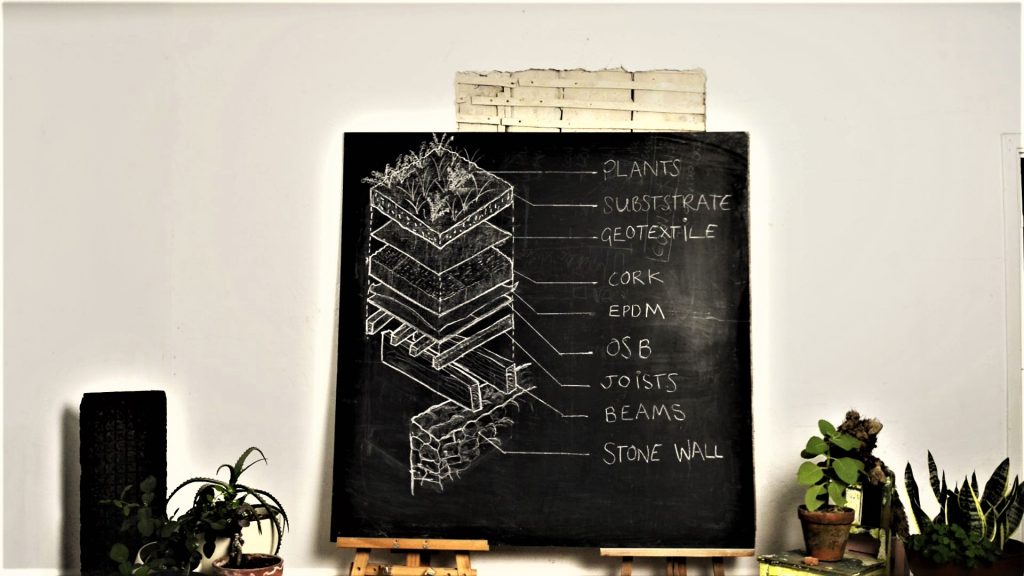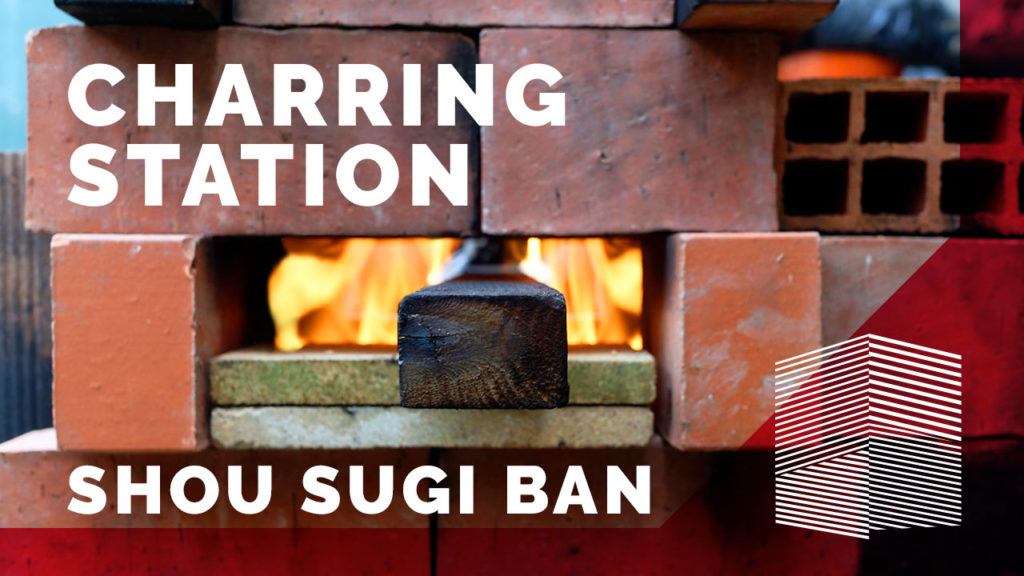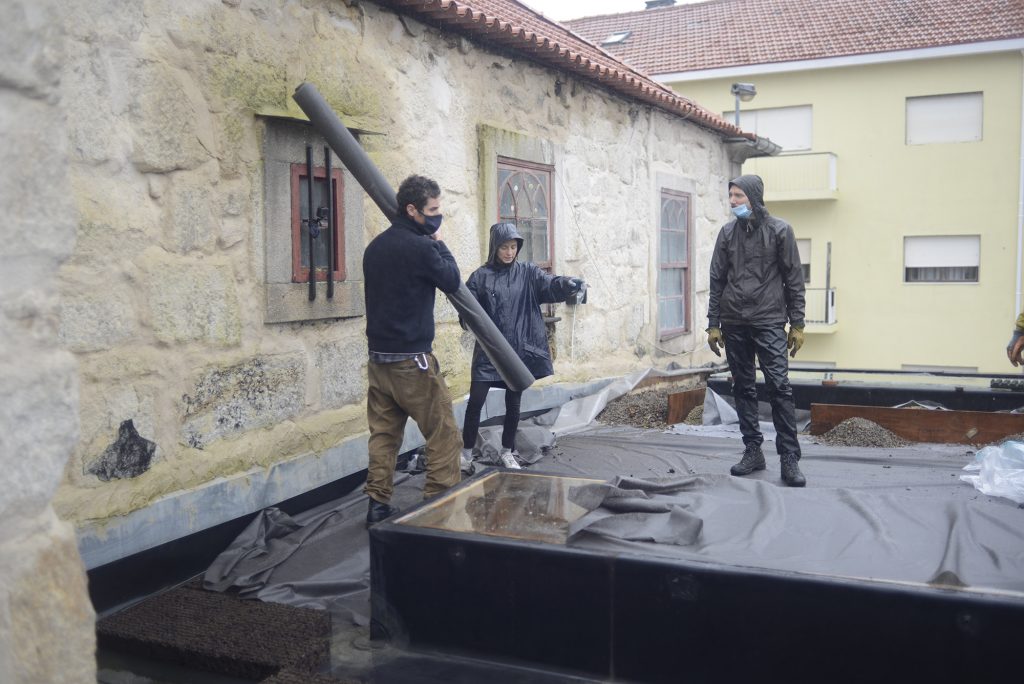After three years of research, design and construction, our 130 square meter roof is finally finished!

We are happy to share with you an overview of all the steps we went through, the sustainable technologies we integrated into this project, and the impact we think green roofs can have on our urban landscapes.
Watch the video below for an explainer of the process of constructing our ecological green roof:
This journey started three years ago with the demolition of the old roof and replacement with a glulam structure. Along the way we integrated several sustainable technologies that we have documented with articles and videos. For instance, we used recycled tyres for the foundations of our wooden wall structure and protected the exterior timber facade using our charring technique inspired in the traditional japanese process of Yakisugi.
For more information about these researches, check our previous articles here.
CHARRING STATION

TYRE FOUNDATION

Green roofs are often proposed as a solution to the lack of green space in urban environments or as a way of slowing down the flow of water. But do conventional green roofs actually deliver on these claims? Our research of modern green roofs found that the materials used in construction often do not align with the sustainability ethos that a green roof proclaims. We sought to find alternatives to plastic filters, insulation, and drainage systems: the materials that typically make up the layers of a green roof. In our mission to adopt low-tech, sustainable architecture and construction techniques we wanted to reduce material consumption and also make it as easy to replicate and apply in other situations as possible.
Our green roof layers

Green Roof detail
EPDM

Laying EPDM around rooflights

EPDM Silicone
We needed a waterproof layer to cover the OSB roof layer and protect from water ingress. We chose EPDM, a synthetic rubber, due to its availability and long life span.
Geotextile
To protect the cork from the plant roots and the substrate a geotextile layer is needed. This prevents silt and other fine particles from clogging the grid drainage system within the cork. Geotextiles are semi permeable fabrics that help separate soil layers but permit the passage of fluids.
Irrigation System
For the climate we enjoy here in Porto an irrigation system is definitely not necessary. However in order to control the parameters of Neoturf’s experiment a system was installed. In the future we will build a rainwater harvesting system that will allow us to store and re-use rainwater for non potable purposes. Watch this space!
Cork Insulation

Cork grid

Laying the cork panels
The most cutting edge element of this design is the inclusion of cork insulation, thanks to a partnership with Neoturf, who conducted the research about this design. This is the first time this design and technology has been implemented on a green roof of this size so we are very excited and hopeful for the results. The expanded cork is a by-product of the industrial process for manufacturing wine corks and is being increasingly used in construction. We explain more about this carbon negative wonder material in a full article here.
Cork is a carbon negative material as the trees it is harvested from absorb CO2 from the atmosphere as they grow. These cork boards provide insulation – with the thermal efficiency of Lambda 0.038-0.040 watts per meter kelvin or R3.6/inch.In cold months this is comparable to synthetic materials such as expanded polystyrene during warm weather synthetic insulation performs very poorly due to having low thermal mass [1]. Additionally, in order to allow water to drain a grid was pre-cut into the panels: vital to withstand Porto’s frequent downpours. By using this design and material we negate the need for synthetic insulation, plastic drainage cups, and other plastic liners.
Substrates



The second experimental aspect of our green roof is being investigated in partnership with Neoturf, who specialise in landscape design and nature based solutions. The soil that is used on green roofs cannot be composed of simply hummus. It requires other gravels or materials that reduce compaction and promote effective drainage. Neoturf are investigating how well 3 different substrates that use recycled construction waste perform in contrast to the commercially available alternative. Should this research prove successful they will promote the widespread use of recycled waste as substrate across the industry. Over the next two years they will monitor the progress of the plants growing on our roof.
Interview with Paolo Palha from Neoturf
Check out an in-depth interview with Paolo Palha, researcher and engineer from Neoturf, that gives us insights into the significance of his research and what they are expecting to find in the next couple of years, monitoring the plants’ growth:



Conclusion
This green roof represents three years of hard work, prototype development, and teamwork. Countless hands have helped repair walls, build structure, haul earth and the thousands of other tasks needed to realise this ambitious project. We send huge love and thanks to everyone who has helped in any way. This is a major milestone for us and we are excited to see our plants grow healthy and strong. Neoturf will continue with this research over the next two years, after which we can adapt the roof to grow our own food and reach a higher level of self-sustainability.












Are you interested in implementing an ecological green roof in your project? Critical Concrete can provide advice, design and construction services for the whole process: including structure, procurement and material sourcing. Contact our studio today!
Interested in using this technology in your project?
Critical Studio can help!
Learn More!
We need your support to continue researching and developing ecological, low tech solutions. Check out our patreon to see what perks we offer in return for helping us on our sustainable mission.
The post How to make green roofs really green? first appeared on Critical Concrete.
Always check our latest articles at…
https://www.akbarconcreteworks.com//category/reinforced-concrete